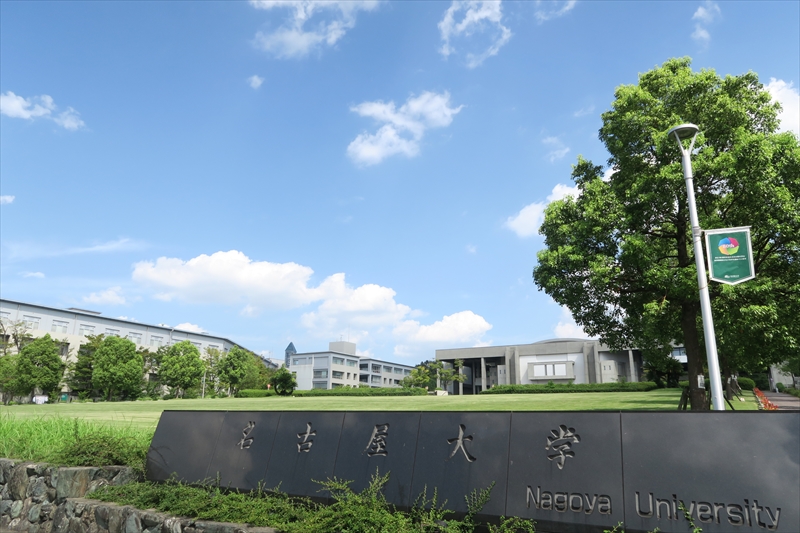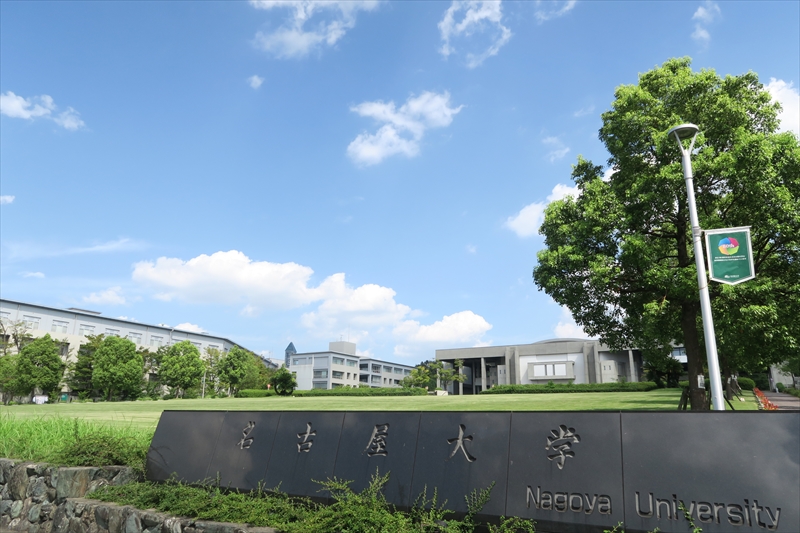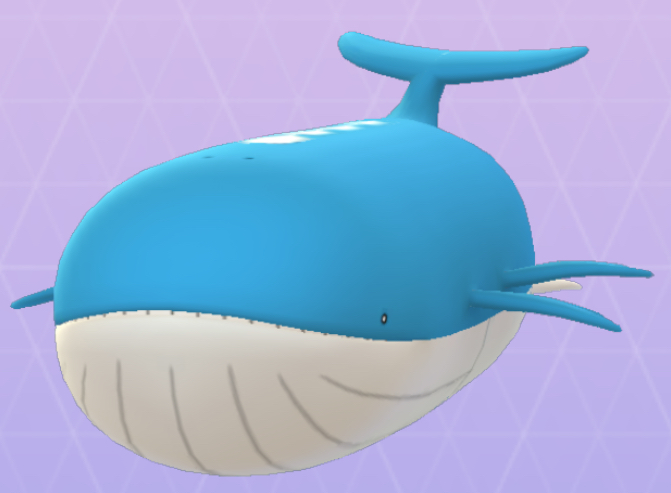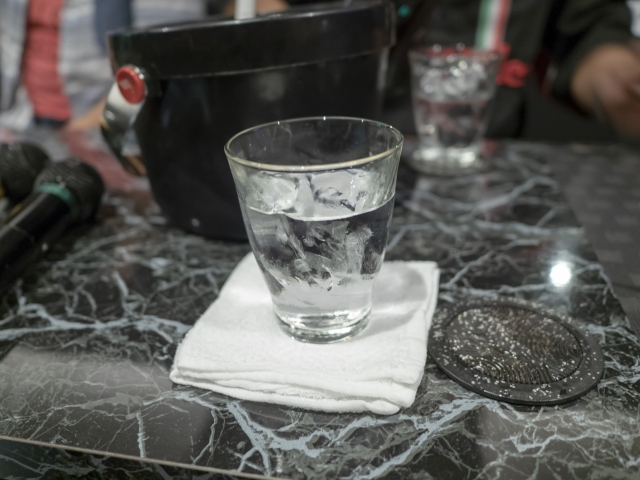名大理学研究科院試解答・2020解析力学
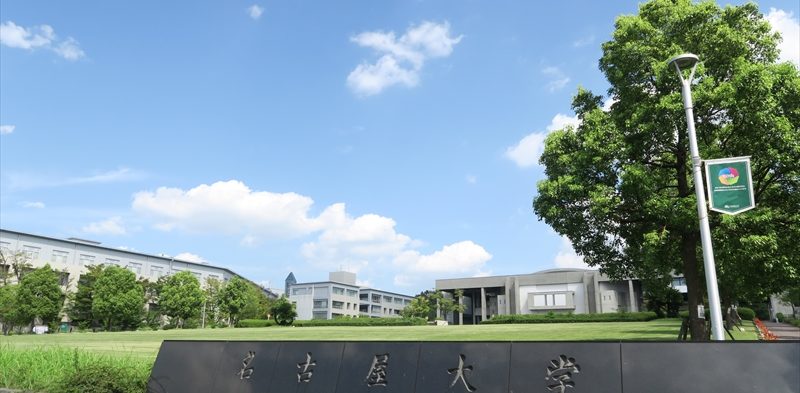
名大理学研究科院試解答・2020解析力学
2020年4月15日
名古屋大学大学院理学研究科物理学系・院試解答
2020年度解析力学
問題はこちら
入試データ
解答の訂正等はこちらへお願いします。アドレス:yasketballclub@gmail.com
メールはこちらへ
※スマホ等で見る場合、式が途切れちゃうことがあると思うのでその時は画面を横にして見てください
スポンサーリンク
解析力学
問1
\begin{eqnarray}
\begin{split}
\vec{OC}&=&
R\left(
\begin{array}{ccc}
cos\left(\frac{\pi}{2}-\theta\right) \\
sin\left(\frac{\pi}{2}-\theta\right)
\end{array}
\right)\\
&=&
R\left(
\begin{array}{ccc}
sin\theta \\
cos\theta
\end{array}
\right)
\end{split}
\end{eqnarray}
である。このように考えれば
\begin{eqnarray}
\begin{split}
\vec{CP}&=&
R\theta\left(
\begin{array}{ccc}
cos\left(\pi -\theta\right)\\
sin\left(\pi -\theta\right)\\
\end{array}
\right)\\
&=&R\theta
\left(
\begin{array}{ccc}
-cos\theta\\
sin\theta\\
\end{array}
\right)\\
\end{split}
\end{eqnarray}
よって
\begin{eqnarray}
\begin{split}
\vec{OP}&=&R
\left(
\begin{array}{ccc}
sin\theta -\theta cos\theta\\
cos\theta+\theta sin\theta\\
\end{array}
\right)\\
\end{split}
\end{eqnarray}
問2
\begin{eqnarray}
\begin{split}
\frac{d}{dt}\vec{OP}&=&R
\left(
\begin{array}{ccc}
\dot{\theta}cos\theta-\dot{\theta}cos\theta+\theta\dot{\theta}sin{\theta}\\
-\dot{\theta}sin\theta+\dot{\theta}sin\theta+\theta\dot{\theta}cos{\theta}\\
\end{array}
\right)\\
&=&R\theta\dot{\theta}
\left(
\begin{array}{ccc}
sin\theta\\
cos\theta
\end{array}
\right)\\
\end{split}
\end{eqnarray}
よって
\begin{eqnarray}
\left(
\begin{array}{ccc}
v_x \\
v_y
\end{array}
\right)=R\theta\dot{\theta}
\left(
\begin{array}{ccc}
sin\theta\\
cos\theta
\end{array}
\right)\\
\end{eqnarray}
であり、\( |\vec{v}|^2=R^2\theta^2\dot{\theta}^2\)となる。
問3
問2より
\begin{eqnarray}
\begin{split}
\mathcal{L}&=&\frac{m}{2}|\vec{v}|^2\\
&=&\frac{m}{2}R^2\theta^2\dot{\theta}^2
\end{split}
\end{eqnarray}
である。
問4
\begin{eqnarray}
\begin{split}
\frac{\partial\mathcal{L}}{\partial\theta}&=&mR^2\theta\dot{\theta}^2\\
\frac{\partial\mathcal{L}}{\partial\dot{\theta}}&=&mR^2\theta^2\dot{\theta}
\end{split}
\end{eqnarray}
また
\begin{eqnarray}
\begin{split}
\frac{d}{dt}\left(\frac{\partial\mathcal{L}}{\partial\dot{\theta}}\right)&=&2mR^2\theta\dot{\theta}^2+mR^2\theta^2\ddot{\theta}
\end{split}
\end{eqnarray}
よってオイラー・ラグランジュ方程式は
\begin{eqnarray}
\begin{split}
2mR^2\theta\dot{\theta}^2+mR^2\theta^2\ddot{\theta}&=&mR^2\theta\dot{\theta}^2\\
\Leftrightarrow \theta\ddot{\theta}+2\theta\dot{\theta}^2&=&\theta\dot{\theta}^2\\
\Leftrightarrow \theta\ddot{\theta}+\theta\dot{\theta}^2&=&0
\end{split}
\end{eqnarray}
となる。
問5
問4で得られた方程式は
\begin{eqnarray}
\begin{split}
\ddot{\theta}&=&-\frac{\dot{\theta}^2}{\theta}\\
\Leftrightarrow\frac{\ddot{\theta}}{\dot{\theta}}&=&-\frac{\dot{\theta}}{\theta}
\end{split}
\end{eqnarray}
と変形できる。
これを不定積分すると
\begin{eqnarray}
\begin{split}
ln\dot{\theta}&=&-ln\theta+C\\
&=&ln\frac{C}{\theta}\\
\Rightarrow \dot{\theta}\theta&=&\theta
\end{split}
\end{eqnarray}
さらにこれを不定積分すると
\begin{eqnarray}
\begin{split}
\theta^2&=&2Ct+D\\
\theta&=&\pm \sqrt{2Ct+D}
\end{split}
\end{eqnarray}
ここで問題の設定より\( \theta(t=0)=0\)なので\( D=0\)。
また、\( R\theta\dot{\theta}=v_0\)より
\begin{eqnarray}
\begin{split}
\theta\dot{\theta}&=&C\\
&=&\frac{v_0}{R}
\end{split}
\end{eqnarray}
\( \theta\)の取り方からマイナスは不適であるので
\begin{eqnarray}
\theta=\sqrt{2\frac{v_0}{R}t}
\end{eqnarray}
となる。
スポンサーリンク
問6
\begin{eqnarray}
\begin{split}
m{\bf{r}}×{\bf{v}}&=&m\vec{OP}×\frac{d}{dt}\vec{OP}\\
&=&m(\vec{OC}+\vec{CP})×\theta\dot{\theta}\vec{OC}\\
&=&m\theta\dot{\theta}\vec{CP}×\vec{OC}\\
\end{split}
\end{eqnarray}
\( |\vec{CP}|=R\theta,|\vec{OC}|=R\)であるので
\begin{eqnarray}
|{\bf{L}}|=mR^2\theta^2\dot{\theta}
\end{eqnarray}
であり
\begin{eqnarray}
\begin{split}
\frac{d}{dt}|{\bf{L}}|&=&mR^2\frac{d}{dt}(\theta^2\dot{\theta})\\
&=&mR^2(2\theta\dot{\theta}^2+\theta^2\ddot{\theta})
\end{split}
\end{eqnarray}
問4より
\begin{eqnarray}
\theta\ddot{\theta}+2\theta\dot{\theta}^2&=&\theta\dot{\theta}^2
\end{eqnarray}
であり\( \dot{\theta}^2\neq 0,\theta\neq 0\)より角運動量は保存しない。
\( \ast 別解\)
(問5より\( \theta\)を用い具体的に計算してみると
\begin{eqnarray}
\frac{d}{dt}|{\bf{L}}|\propto -\frac{1}{2\sqrt{t}}\neq 0
\end{eqnarray}
より角運動量は保存しない。)
保存しない理由は円筒を固定するための外力が系に働いているからである。
問7
\begin{eqnarray}
\begin{split}
H&=&p\dot{q}-L\\
&=&\frac12 mv^2
\end{split}
\end{eqnarray}
\begin{eqnarray}
\dot{H}=\ mv\dot{v}
\end{eqnarray}
ここで問4より
\begin{eqnarray}
\begin{split}
\dot{v}&=&R\left( \dot{\theta}^2+\theta\ddot{\theta}\right)\\
&=&0
\end{split}
\end{eqnarray}
であるので運動エネルギーは保存する。
保存する理由は物体に働く力と速度が直交しているからである。
問8
\begin{eqnarray}
\begin{split}
\vec{OC}&=&
R\left(
\begin{array}{ccc}
sin\left(\theta+\psi\right) \\
cos\left(\theta+\psi\right)
\end{array}
\right)
\end{split}
\end{eqnarray}
\begin{eqnarray}
\begin{split}
\vec{CP}&=&
R\theta\left(
\begin{array}{ccc}
-cos\left(\theta+\psi\right) \\
sin\left(\theta+\psi\right)
\end{array}
\right)
\end{split}
\end{eqnarray}
より
\begin{eqnarray}
\begin{split}
\vec{OP}&=&
R\theta\left(
\begin{array}{ccc}
sin\left(\theta+\psi\right)-\theta cos\left(\theta+\psi\right) \\
cos\left(\theta+\psi\right)+\theta sin\left(\theta+\psi\right)
\end{array}
\right)
\end{split}
\end{eqnarray}
\begin{eqnarray}
\begin{split}
\frac{d}{dt}\vec{0P}&=&
R\theta\left(
\begin{array}{ccc}
\dot{\psi}cos\left(\theta+\psi\right)+\theta\left(\dot{\theta}+\dot{\psi}\right)sin\left(\theta+\psi\right)\\
-\dot{\psi}sin\left(\theta+\psi\right)+\theta\left(\dot{\theta}+\dot{\psi}\right)cos\left(\theta+\psi\right)
\end{array}
\right)
\end{split}
\end{eqnarray}
\( \frac{d}{dt}\vec{OP}=\vec{v}\)であるので
\begin{eqnarray}
\begin{split}
|\vec{v}|^2=R^2\left( \dot{\psi}^2+\theta^2\left( \dot{\theta}+\dot{\psi} \right)^2 \right)
\end{split}
\end{eqnarray}
よって
\begin{eqnarray}
\begin{split}
L=\frac{mR^2}{2}\left( \dot{\psi}^2+\theta^2\left( \dot{\theta}+\dot{\psi} \right)^2 \right)
+\frac{I}{2}\left( \dot{\theta}+\dot{\psi} \right)^2
\end{split}
\end{eqnarray}
問9
\( \theta\)について
\begin{eqnarray}
\frac{\partial L}{\partial \dot{\theta}}=mR^2\dot{\theta}^2\left(\dot{\theta}+\dot{\psi}\right)+I\left(\dot{\theta}+\dot{\psi}\right)
\end{eqnarray}
\begin{eqnarray}
\frac{\partial L}{\partial \theta}=mR^2\theta\left(\dot{\theta}+\dot{\psi}\right)^2
\end{eqnarray}
よってオイラー・ラグランジュ方程式は
\begin{eqnarray}
\frac{d}{dt}\left\{mR^2\dot{\theta}^2\left(\dot{\theta}+\dot{\psi}\right)+I\left(\dot{\theta}+\dot{\psi}\right)\right\}=mR^2\theta\left(\dot{\theta}+\dot{\psi}\right)^2
\end{eqnarray}
\( \psi\)について
\begin{eqnarray}
\frac{\partial L}{\partial \dot{\psi}}=mR^2\left(\dot{\psi}+\theta^2\left( \dot{\theta}+\dot{\psi} \right)+I\left( \dot{\theta}+\dot{\psi} \right) \right)
\end{eqnarray}
\begin{eqnarray}
\frac{\partial L}{\partial \psi}=0
\end{eqnarray}
よってオイラー・ラグランジュ方程式は
\begin{eqnarray}
\frac{d}{dt}\left\{mR^2\left(\dot{\psi}+\theta^2\left( \dot{\theta}+\dot{\psi} \right)\right)+I\left( \dot{\theta}+\dot{\psi} \right) \right\}=0
\end{eqnarray}
問10
質点の角運動量を考える。
\begin{eqnarray}
\begin{split}
mR^2\left(
\begin{array}{ccc}
sin\left(\theta+\psi\right)-\theta cos\left(\theta+\psi\right) \\
cos\left(\theta+\psi\right)+\theta sin\left(\theta+\psi\right) \\
0
\end{array}
\right)&×&\left(
\begin{array}{ccc}
\dot{\psi}cos\left(\theta+\psi\right)+\dot{\theta}\left( \dot{\theta}+\dot{\psi} \right)sin\left(\theta+\psi\right) \\
-\dot{\psi}sin\left(\theta+\psi\right) +\theta \left( \dot{\theta}+\dot{\psi} \right)cos\left(\theta+\psi\right) \\
0
\end{array}
\right)\\
&=&mR^2\left(
\begin{array}{ccc}
0 \\
0 \\
-\dot{\psi}-\theta^2\left( \dot{\theta}+\dot{\psi} \right)
\end{array}
\right)
\end{split}
\end{eqnarray}
円盤の角運動量が
\begin{eqnarray}
\begin{split}
\vec{OC}&=&
R\left(
\begin{array}{ccc}
0 \\
0 \\
-I\left( \dot{\theta}+\dot{\psi} \right)
\end{array}
\right)
\end{split}
\end{eqnarray}
であるので\( \psi\)についてのオイラー・ラグランジュ方程式より、保存量は質点と円盤の全角運動量である。
問11
\( t=0\)で全角運動量\( 0\)であるので\( \psi\)のついてのオイラーラグランジュ方程式より
\begin{eqnarray}
mR^2\left(\dot{\psi}+\theta^2\left( \dot{\theta}+\dot{\psi} \right)\right)+I\left( \dot{\theta}+\dot{\psi} \right)=0
\end{eqnarray}
となり、\( \dot{\theta}>0\)より\( \dot{\psi}<0\)となる。
つまり反時計まわり。
問12
円盤の回転エネルギーが発生するため、質点のエネルギーは保存しない。
スポンサーリンク





